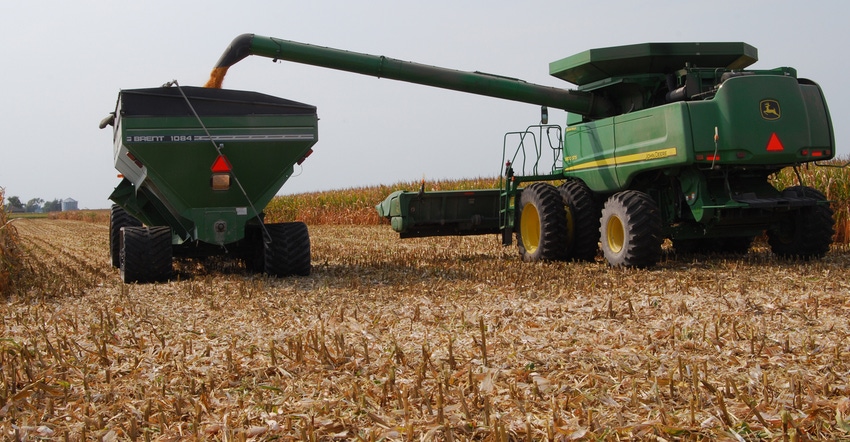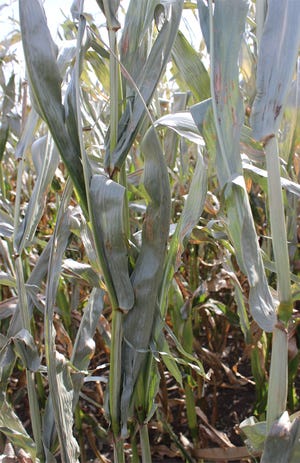October 14, 2019

How should you manage corn hit by frost before the grain in the field reaches natural maturity? A portion of Iowa’s corn crop is in this situation as temperatures on Oct. 11-12 dropped below freezing. The growing season for soybeans also came to an end.
The impact of freezing to below-freezing temperatures on corn depends on how low the temperatures get and how far along the crop is in kernel development, says Charlie Hurburgh, Iowa State University grain quality specialist. Hurburgh and ISU Extension agronomist Mark Licht offer the following observations and guidelines to help growers manage this year’s harvest.
Natural maturity for corn is often determined when a black layer is formed at the kernel tip. At this time frame grain moisture is typically 28% to 35% moisture. If a frost or freeze occurs, the black layer can still form; however, grain moisture will be greater than 35%. A light frost of greater than 28 degrees F for only a couple hours may kill some leaves, especially in the upper canopy. A freeze of 28 degrees or less for a couple hours will result in whole plant death.
Lower test weight, higher moisture
Whether corn maturity is natural or induced by a frost, grain dry matter accumulation has finished. Incomplete grain fill from a frost or freeze often results in corn with low test weight and moisture content greater than 35%. The severity of that effect depends on how far the milk line has progressed at the time of the cold temperatures.
 VARIABILITY: Variability in corn maturity varies greatly this fall. Elevators may cut farmers some slack on discounts if farmers don’t mix frost-damaged corn with grain that’s fully mature.
VARIABILITY: Variability in corn maturity varies greatly this fall. Elevators may cut farmers some slack on discounts if farmers don’t mix frost-damaged corn with grain that’s fully mature.

At quarter milk line, the kernel moisture will be higher, and the kernel weight will be lower compared to a three-quarter milk line. You can expect drydown of the grain in the field to take longer because of higher kernel moisture and slower drydown rates, as there is continued moisture exchange with the cob.
Grain yield decreases more the earlier that a killing frost occurs (ranging from 12% in late dent up to 41% at beginning dent stage). Yield losses are also less when only leaves are killed (ranging from 6% in late dent up to 27% at beginning dent). In addition to lower yield, incomplete grain fill will occur, resulting in a lower test weight. Expect test weight to be in the low 50s to 40s (pounds per bushel).
Lighter kernels will require fine-tuning adjustments to combine settings. Also, keep in mind that the effects frost and freeze have on corn ahead of natural maturity result in more susceptibility to kernels breaking, lower grain protein and lower digestibility.
Grain moisture of frost-injured corn can be is deceptively low after drying because the outer portion of the kernel dries quicker than the interior. Often grain moisture is 1% to 2% higher than indicated by many on-farm grain moisture meters. However, the newer 150 mhz units used by many elevators are more accurate in these situations. You should dry frost-killed corn to a 1% to 2% lower moisture content for storage than the typical 14% to 15%, and cool that grain as quickly as possible. It will take more energy per unit of moisture removed to dry frost-damaged corn. The storage life of corn drops rapidly when test weight is below 53 pounds per bushel.
You should dry frost-killed corn to a 1% to 2% lower moisture content for storage than the typical 14% to 15% and cool that grain as quickly as possible. It will take more energy per unit of moisture removed to dry frost-damaged corn. The storage life of corn drops rapidly when test weight is below 53 pounds per bushel.
Managing frosted soybeans
“For immature soybeans killed by frost, we’ll have problems with storability, although test weight is not much of a factor with beans,” Hurburgh says. “Soybean maturity is measured mostly by the degree to which the greenness is gone. If we have yellow, oblong beans in pods, that means they’ve reached maturity and are just wet. That will probably take care of itself as the beans dry down.”
He adds, “However, if we have green beans in pods, those aren’t going to get any better in terms of quality. And we’ll have some storage problems and soyoil processing problems with green beans that get caught by frost.”
For more information on harvesting and handling frost-injured crops, visit these online resources:
Replant crops at harvest
An Iowa farmer sent an email in anticipation of the freeze that was forecast for the overnight of Oct. 11. Many farmers are in a similar position this fall of having mature crops in the same field with replanted crops that may not be mature yet — and the first killing frost is coming. Here’s the question, and how Iowa State University grain quality specialist Charlie Hurburgh answered it.
I have May-planted corn that is mature and looks good, but approximately 20% of the acreage was replanted in June and scattered throughout the field. That corn is small and has insect feeding and some ear mold. The corn is between a quarter and half milk line. Do I combine the field to blend the June corn in with the May or combine the two separately? Please don’t blend it in the field. Corn that is not yet mature will likely be in the mid or upper 30s for moisture percentage and will have a low-test weight, making it very difficult to store.
If you take the corn directly to the elevator, it will be the luck of the draw on what they get for a sample. Additionally, if you chose to store blended corn yourself on the farm, problems with spoilage would be a near certainty.
Instead, leave the June-planted corn in the field until the end of harvest. Your elevator may cut you some slack on discounts if you discuss the situation with them and bring the light corn in separately. Ultimately, it is easier for both them and you to manage with all the light corn together in a separate bin, rather than unpredictably scattered with better corn in a large bin.
While this response is directed toward those farmers with fields of variably maturing corn, the answer would remain the same for those with replant soybeans that will mature later than other soybeans in the same field.
Another recent ICM Blog article on Harvest considerations for frost-killed corn is worth reviewing, but if you have further questions about handling grain with low test weights or damage, reach out to your local field agronomist.

Both temperature and moisture are important in grain preservation, but often, temperature control is the most immediately important if drying capacity is limited.

About the Author(s)
You May Also Like






